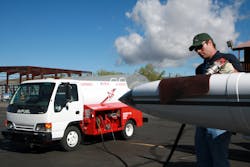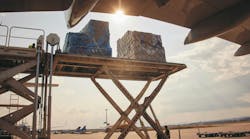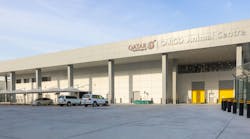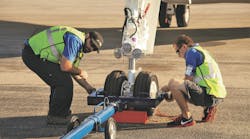Safe operation of aircraft while on the ground is a shared responsibility. The cockpit crew is charged with maneuvering the aircraft to and from the departure/arrival area on to or off of the active runway. This should be accomplished with a high level of awareness for potential hazards. There are, of course, certain other activities occupying crew member attention during ground operations including communicating with ground control or their flight operations department regarding special needs or instructions and there are always the pre or post flight checklists to attend to. Nevertheless they do still need to report irregularities with paved surfaces, defective or broken taxi lights and most anything else that could be perceived as a potential hazard. Several technological marvels including a pilot-controlled tug are under development to allow aircraft engines to be started after the aircraft is prepositioned for takeoff. Other significant achievements in preventing runway incursions have been forthcoming including Runway Awareness and Advisory System (RAAS) which improves the awareness of the flight deck crew to outside activities.
U.S. Department of Transportation’s Bureau of Transportation Statistics (BTS) reported in 2015, U.S. based and foreign airlines serving the United States carried an all-time high of 895.5 million system wide (domestic and international) scheduled service passengers with expectations of again breaking the record in 2016. Both Boeing and Airbus have issued industry reports projecting the world’s aviation fleet will double in size within the next 20 years. These forecasts do not include business or general aviation but significant new aircraft deliveries are anticipated in these markets as well.
Evolutions with technology
Handling the new along with the existing fleet is only part of the challenge faced by those involved in support activities. Evolutions with technology has mandated adaptations in how we conduct routine activities. Many commercial airports have implemented infrastructure changes to handle the newer super jumbo airliners such as the Airbus A380 with a maximum takeoff weight of 1,268,000 pounds while general aviation facilities have increased runway, hangars and ramp capabilities to support long-range business aircraft. A growing concern globally is the ability to implement a capable and competent workforce to handle the expanding fleet. Ground service technicians often have a very diverse range of duties depending on their aviation affiliation. Frequently those involved in airline operations specialize in one area such as refueling where those in service of the general aviation industry may perform everything from concierge to cleaner. In all cases an appropriate knowledge level is essential.
International Standards
The International Air Transport Association (IATA) Safety Audit of Ground Operations (ISAGO) program is an internationally recognized and accepted system for assessing the operational management and control systems of an organization that provides ground handling services for airlines (the “Provider”). ISAGO is based on industry-proven quality audit principles and structured to ensure a standardized audit with consistent results.
The technical content of the ISAGO Standards and Recommended Practices (GOSARPs) are under continual review and maintenance by industry experts comprised of operational, safety, security and quality specialists from airlines, regulatory authorities and various other industry entities. Special care is taken to ensure a regionally diverse membership and over the long term, IATA will continually review and update to ensure material is current with the needs of industry. The complexity of support equipment and the hazards involved in the ground handling of aircraft requires technicians to have significant knowledge of proactive as well as reactive procedures used in aircraft servicing, taxiing, run-up, use of ground support equipment and maintaining a safe environment for aircraft operations.
The Cost of FOD
One of the biggest contributors to aircraft damage is foreign object debris (FOD) and according to fodprevention.com, FOD can cost the aerospace industry up to $12 billion per year. The direct cost for damaged parts adds up to $4 billion plus indirect costs include flight delays, fuel expenses and court awarded damages.
The U.S. Federal Aviation Administration (FAA) and International Civil Aviation Organization (ICAO) require a daily, daylight inspection of airplane maneuvering areas and removal of FOD. In addition to performing these inspections at the beginning of the day or shift, personnel on the airside should look for FOD during their normal shifts. Ongoing construction requires more frequent inspections. It may even be necessary to assign dedicated personnel to continually inspect for FOD during major construction activities. Flight crews should report to air traffic control and station operations any FOD they observe on runways and taxiways. Airlines and airplane handling agents should designate individuals to inspect gate areas prior to airplane movement to and from the gate.
Maintaining control of FOD includes using several methods: Sweeping using mechanized devices or by hand in areas where significant FOD hazards exist, magnetic bars either pulled behind vehicles or dragged by ground personnel. Rumble strips used in areas dedicated to vehicular traffic are a known contributor to loosening or dislodging pieces or parts and when used in areas where aircraft movement occurs, inspections for debris should occur frequently and regularly. The FAA has investigated FOD detection technologies, and has set standards for several systems that have proved effective including radar detection, electro-optical including visible band imagery and low light cameras.
Other Hazards
FOD is only one of the many hazards to be reckoned with by aircraft service providers. Risks occur with most ground operations and include mechanical as well as electrical hazards, extreme noise levels and intense lights can cause distractions combined with loss of concentration and subsequently, situational awareness will be degraded. Considering many of the activities required for dispatching or recovering an aircraft take place outdoors, contending with Mother Nature can be a significant challenge. Various forms of precipitation and temperature extremes wreak havoc on an unprotected human body and protective attire can sometimes complicate otherwise simple tasks. Recognizing proper work wear is essential as those tasks with working around flammable fluids or gasses can ill afford to have an article of clothing produce an electrical spark.
Electrostatic discharge (ESD) is another prevalent threat and with the increasing use by aircraft manufacturers of composites and acrylics the likelihood of an ESD event during aircraft servicing is possible. A failure of static bonding tabs used to create a path for electron flow from an acrylic windscreen to the surrounding aircraft structure can result in the windshield becoming a charged capacitor while the aircraft is in flight. An unaware technician tasked with cleaning the windscreen during a quick turn may be the recipient of several thousand volts if precautions are not taken. Something as simple as pouring a cup of water on a windscreen prior to touching can provide a discharge path for an electrostatic buildup.
Situations involving risk of exposure to hazardous chemicals or pathogens is another daily occurrence for those in aircraft servicing professions. Knowledge of selecting effective personal protective equipment (PPE) for specific jobs and use of safety data sheets (SDS) to proactively deal with task necessary materials is another critical element. Concerns over terrorism have escalated in recent years and aviation ground services personnel, even though not in the limelight, are on the front line when it comes to identifying potentially threatening individuals or effects in aircraft operating areas and although it may not be their task to challenge it, it is now an essential responsibility to contact appropriate authorities.
Education and Cooperation
Job knowledge is an ever evolving factor in aviation support professions. As technology advances adaptability is the key to success and understanding when changes should be made to achieve specific goals is important but not necessarily making changes just for the sake of change. Mastery of human factors such as the “FAA Dirty Dozen” are essential for support personnel to minimize incidents and accidents related to ramp and other aircraft operating area activities. The known and identified factors impacting human performance, include; fatigue, lack of knowledge, pressure, stress, lack of assertiveness, awareness, lack of teamwork, distractions, poor communications, complacency, norms and lack of information.
The most successful organizations are a result of collaboration and cooperation. In other words; it is the people that make the difference and a well versed ground services team will prevail overcoming the challenges predicted for our industry and ensuring continued safety and security with the increased number of predicted aircraft operations.





